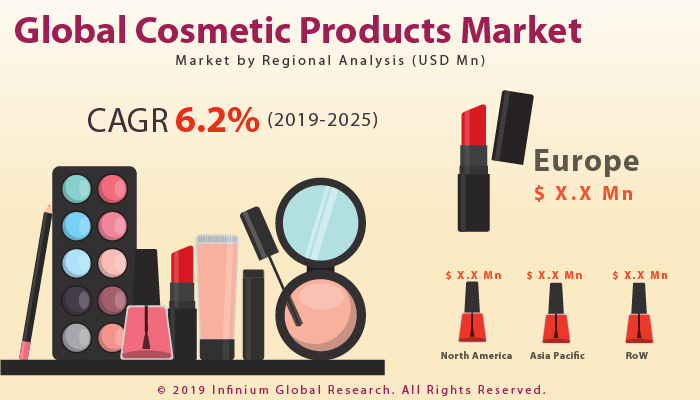Cosmetic Products Market (Product - Color Cosmetics, Skin Care Products, Personal Care Products, Hair Care Products, Fragrances, and Oral Care Products; Form - Solutions, Lotions, Tablets, Ointments, Creams, Suspensions, Sticks, Powders, Aerosols, and Gels; Application - Eyebrows, Hair, Face, Lips, Eyes, and Nails): Global Industry Analysis, Trends, Size, Share and Forecasts to 2025
A recent report published by Infinium Global Research on
cosmetic products market provides in-depth analysis of segments and sub-segments
in the global as well as regional cosmetic products market. The study also
highlights the impact of drivers, restraints, and macro indicators on the
global and regional cosmetic products market over the short term as well as
long term. The report is a comprehensive presentation of trends, forecast and
dollar values of the global cosmetic products market. According to the report, the
global cosmetic products market is projected to grow at a CAGR of 6.2% over the
forecast period of 2019-2025.
Market Insight
The cosmetic products specially
used by humans on various body parts including skin, eyes, lips, eyebrow, hair,
etc. Cosmetic are generally applied by spraying, introduced, rubbing on or in
the human body for cleansing and beautifying the skin. It is mostly utilized
for grooming by a human, largely used in the film industry and fashion. The
cosmetic products industry is one of those industries that remained growing and
unaffected after the economic recession in various major economies.
The global cosmetic products
market is primarily driven by the development of innovative and new products as
per the changing needs of customers. Moreover, the rising demand for cosmetic
products worldwide for cleaning and beautifying skin and hair is expected to
fuel market growth in the near future. However, cases of side effects and
adverse reactions and certain products despite many of the beauty products are
safe for use and are expected to hinder the demand for global cosmetic products
market. Nonetheless, a variety of cosmetic products are available on e-commerce
websites for online buy is anticipated to create a new opportunity for the
global cosmetic products market.
On the basis of region, the
global cosmetic products market is bifurcated into North America, Asia Pacific,
Europe, Latin America, and the Middle East and Africa. Europe held the largest
revenue share for the global cosmetic products market in 2018 owing to large
scale expenditure on personal care and beauty product in the region and the
large scale use of luxury beauty products in the region. The Asia Pacific is
estimated to be the fastest-growing region within the projected years owing to
the influence towards the cosmetic products made by foreign companies and the tendency of youth towards use, such product has made a change in developing
countries including China, India, etc.

Segment Covered
The report on the global cosmetic products market covers
segments such as product, form, and application. On the basis of product, the
sub-markets include color cosmetics, skin care products, personal care
products, hair care products, fragrances, and oral care products. On the basis
of form, the sub-markets include solutions, lotions, tablets, ointments,
creams, suspensions, sticks, powders, aerosols, and gels. On the basis of
application, the sub-markets include eyebrows, hair, face, lips, eyes, and
nails.
Companies Profiled:
The report provides profiles of the companies in the market
such as Alticor, Avon Products Inc., Shiseido, Oriflame Cosmetics Global SA,
The Estee Lauder Companies Inc., Beiersdorf AG, Mary Kay Inc., Procter &
Gamble, Revlon Inc., and Yves Rocher.
Report Highlights:
The report provides deep insights into the demand forecasts,
market trends, and micro and macro indicators. In addition, this report
provides insights into the factors that are driving and restraining the growth
in this market. Moreover, The IGR-Growth Matrix analysis given in the report
brings an insight into the investment areas that existing or new market players
can consider. The report provides insights into the market using analytical
tools such as Porter's five forces analysis and DRO analysis of the cosmetic
products market. Moreover, the study highlights current market trends and
provides forecast from 2019-2025. We also have highlighted future trends in the
market that will affect the demand during the forecast period. Moreover, the
competitive analysis given in each regional market brings an insight into the
market share of the leading players.
